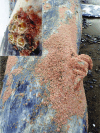Gray whale (Eschrichtius robustus) post-mortem findings from December 2018 through 2021 during the Unusual Mortality Event in the Eastern North Pacific
- PMID: 38536874
- PMCID: PMC10971505
- DOI: 10.1371/journal.pone.0295861
Gray whale (Eschrichtius robustus) post-mortem findings from December 2018 through 2021 during the Unusual Mortality Event in the Eastern North Pacific
Abstract
Beginning in December 2018, increased numbers of gray whale (Eschrichtius robustus) strandings were reported along the west coast of Mexico, the United States, and Canada, prompting declaration of a gray whale Unusual Mortality Event (UME) by the United States National Marine Fisheries Service. Although strandings declined in 2020 and 2021 from a peak in 2019, the UME is still ongoing as of fall 2023. Between 17 December 2018 and 31 December 2021, 503 animals stranded along the west coast of North America, with 226 strandings in Mexico, 71 in California, 12 in Oregon, 56 in Washington, 21 in British Columbia, and 117 in Alaska. These included 187 males, 167 females, and 149 whales of undetermined sex; and 193 adults, 194 subadults, 40 calves, 1 fetus, and 75 whales of undetermined age class. We report on 61 of the 503 carcasses (12%) that had external and internal gross necropsy and/or histopathology data: of these 61 whales, findings that contributed to death were identified in 33 (54%) whales. Sixteen of the 61 (26%) were severely emaciated. Gross lesions of blunt force trauma consistent with vessel strike were identified in 11 of the 61 animals (18%), only two of which were emaciated. Two whales (3%) were entangled at time of death, and one died from entrapment. Signs of killer whale (Orcinus orca) interaction were documented in 19 of the 61 animals; five were deemed from recent interactions and three (5%) likely contributed to mortality. A specific cause of death could not be identified in 28 of 61 whales (46%). Additionally, logistical challenges and the advanced state of decomposition of most examined carcasses precluded detection of potential infectious or toxic causes of morbidity or mortality. Up to 2016, the eastern North Pacific population of gray whale population had generally been increasing since the cessation of historic whaling and a prior UME in 1999-2000. However, recent abundance and calf production estimates have declined, a trend that overlaps the current UME. The relative contributions of carrying capacity, environmental change, prey shifts, and infectious, toxic, and other processes to the increased gray whale mortalities have not yet been resolved. Nevertheless, the marked temporal increase in strandings, including findings of malnutrition in some of the whales, along with low calf production, likely represent consequences of complex and dynamic ecological interactions in the ocean impacting the population.
Copyright: This is an open access article, free of all copyright, and may be freely reproduced, distributed, transmitted, modified, built upon, or otherwise used by anyone for any lawful purpose. The work is made available under the Creative Commons CC0 public domain dedication.
Conflict of interest statement
The authors have no competing interests.
Figures







References
-
- Lang AR, Weller DW, Burdin AM, Robertson K, Sychenko O, Urbán RJ, et al.. Population structure of North Pacific gray whales in light of trans-Pacific movements. Mar Mamm Sci. 2022; 38:433–468.
-
- Harris J, Calambokidis J, Perez A, Mahoney P J. Recent trends in the abundance of seasonal gray whales (Eschrichtius robustus) in the Pacific Northwest, 1996–2020. 2022; AFSC Processed Rep. 2022. –05, 22 pp.
-
- Rice DW, Wolman AA. The life history of the gray whale, (Eschrichtius robustus). American Society of Mammologists. 1971; Special Publication 3. 142pp.
-
- Stewart JD, Weller DW. Abundance of Eastern North Pacific gray whales 2-19/2020. U.S. Dept. Comm., NOAA Technical Memorandum. 2021; NMFS-SWFSC-639.
MeSH terms
LinkOut - more resources
Full Text Sources

